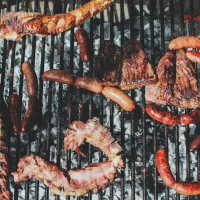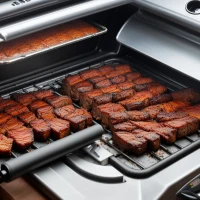Smoking a brisket to perfection is a rite of passage for any barbecue enthusiast. It’s the quintessential challenge that pits patience and technique against the raw beauty of marbled beef. When smoked correctly, a brisket yields succulent, flavorful meat with a tender texture that can only be achieved through slow cooking at low temperatures. Among the most debated subjects in BBQ circles is the optimal temperature for smoking brisket. In this comprehensive guide, we’ll delve into the art and science of smoking brisket at 250°, the temperature sweet spot that balances time and tenderness for an impeccable result. Armed with our insights, you’ll be ready to master the 250° smoke technique and elevate your brisket game to new heights.
Understanding Brisket and the 250° Smoke Technique
Before diving into the specifics of smoking a brisket at 250°, let’s explore what makes this cut of meat so special and why the 250-degree smoke technique stands out in the realm of barbecue.
What is Brisket?
Brisket is a cut of beef that comes from the lower chest or pectoral muscles of the cow. It is known for its dense connective tissue and marbling of fat, which require a long, slow cooking process to break down. This makes it an ideal candidate for smoking, a method that not only tenderizes the meat but also infuses it with an irresistible smoky flavor.
Why Choose 250° for Smoking Brisket?
Smoking brisket at 250° strikes the perfect balance by providing enough heat to slowly render the fat and break down collagen without drying out the meat. This temperature allows for a steady and controlled cook, leading to a juicy, flavor-packed brisket. It’s the harmonious compromise between the low-and-slow philosophy and the practicality of time management.
Preparing Your Brisket for the Smoke
Before you can even think about temperature, proper preparation of your brisket is crucial to achieving the best results. Here’s how to get your brisket ready for the smoker:
Selecting the Right Brisket
- Look for a brisket with good marbling; this fat content is key to a moist and flavorful end product.
- Choose a cut with an even thickness to prevent uneven cooking.
- Consider the grade of the beef; USDA Prime or Choice briskets are usually the best options for smoking.
Trimming the Brisket
- Carefully trim the fat cap to an even thickness (about 1/4 inch). Too much fat may prevent smoke penetration, while too little can dry out the brisket.
- Remove any silver skin or excess fat from the meat side to enhance seasoning absorption.
Seasoning the Brisket
- Season the brisket liberally with a simple but effective rub consisting of salt, black pepper, and optionally, other spices like garlic powder and paprika.
- Apply the rub evenly to all sides of the brisket, ensuring the spices create a beautiful crust during the smoke.
The Smoking Process at 250°
Now that your brisket is prepped and seasoned, it’s time to move on to the smoking process, the stage where magic happens. Smoking a brisket at 250° is more than just setting a temperature; it’s about understanding airflow, wood choice, and maintaining the ideal environment for your meat to transform.
Managing Your Smoker
- Ensure your smoker reaches a steady 250° and the heat is evenly distributed.
- Use a water pan to maintain moisture levels within the smoker, crucial for a long cook.
- Regularly monitor the temperature to avoid peaks and troughs that can affect the consistency of your cook.
Choosing the Right Wood for Flavor
- Select woods like hickory, oak, or pecan for a robust smoke flavor that complements the richness of brisket.
- Avoid overly strong woods like mesquite, which can overpower the meat’s natural flavors.
Smoking Time: The Low and Slow Philosophy
- Expect the smoking process to last anywhere from 8 to 16 hours, depending on the size of your brisket.
- Resist the temptation to open the smoker too often; every peek releases valuable smoke and heat.
Monitoring and Controlling Temperature Fluctuations
Maintaining a consistent temperature is key to a successful smoke. Here’s how to manage it:
Use Reliable Thermometers
- Invest in a good-quality meat thermometer to monitor the brisket’s internal temperature.
- Use a separate grill thermometer to keep an eye on the smoker’s ambient temperature.
Temperature Control Tips
- Make small adjustments to the air vents to fine-tune the temperature, remembering that it’s easier to increase heat than to decrease it.
- Keep a close watch on fuel levels and be prepared to add more charcoal or wood as needed to sustain the 250°.
The Final Stretch: Checking for Doneness
As your brisket smokes, its journey to perfection hinges upon recognizing when it’s reached the point of doneness. No two briskets are the same, so it’s important to use both temperature and texture as indicators.
Internal Temperature: The Magic Number
- Aim for an internal temperature of around 195° to 205°F, the range at which brisket collagen transforms into gelatin, rendering a tender texture.
- Use your meat thermometer to check the temperature in the thickest part of the brisket without touching the bone or fat.
The ‘Probe Test’ for Ultimate Tenderness
- Beyond just internal temperature, the ‘probe test’ involves inserting a skewer or probe into the brisket. The meat should feel like soft butter with little resistance.
- Perform this test in several parts of the brisket to ensure even doneness.
Resting the Brisket: The Unsung Hero of Tenderness
You’ve smoked your brisket to perfection, but before you slice into it, you must let it rest. This is an often overlooked yet critical phase.
Why Resting is Essential
- Resting allows the juices to redistribute throughout the meat, ensuring each bite is succulent.
- The heat within the brisket continues to break down any remaining connective tissue, tenderizing it further.
How to Rest Your Brisket
- Remove the brisket from the smoker and wrap it in butcher paper or aluminum foil. This will retain heat without making the bark soggy.
- Allow the brisket to rest for at least 1 hour; larger cuts may benefit from longer rest periods.
Carving Against the Grain: Serving Your Brisket
Your brisket has been chosen, trimmed, seasoned, smoked, and rested. Now, it’s time to serve. The final step is as vital as the rest - carving the brisket correctly ensures each slice is as tender as possible.
The Importance of Slicing Against the Grain
- Meat fibers run in a certain direction; slicing against them shortens the fibers, making the meat easier to chew.
- Locate the grain before you begin slicing, which may change direction in different parts of the brisket.
Tips for Perfect Slices
- Use a sharp knife; a dull knife may shred the meat and ruin the bark you worked hard to achieve.
- Aim for slices about the width of a pencil, which hold together but are not too thick.
Mastering the 250° Smoke Technique: A Summary
Smoking brisket at 250° is an art form that balances scientific precision with the nuances of flavor and texture. From selecting and preparing your brisket to managing the smoke and carving the final product, each step contributes to the ultimate goal: a beautifully smoked piece of beef. Remember these key points to ensure your brisket is a masterpiece:
- Select a brisket with good marbling and an even fat cap.
- Season liberally and let the flavors of your rub shine.
- Maintain a consistent 250° and a moist environment in your smoker.
- Monitor the meat’s internal temperature but also use the probe test for doneness.
- Rest the brisket to achieve optimum tenderness.
- Carve against the grain for maximum enjoyment.
Slow-smoked brisket is more than just a barbecue dish; it’s an expression of patience and skill, and at 250°, you have what it takes to make every slice count. Whether you’re a seasoned pitmaster or a curious beginner, the journey to brisket perfection is an endlessly rewarding pursuit. Now, fire up that smoker, and let the sweet smoke do its work.










